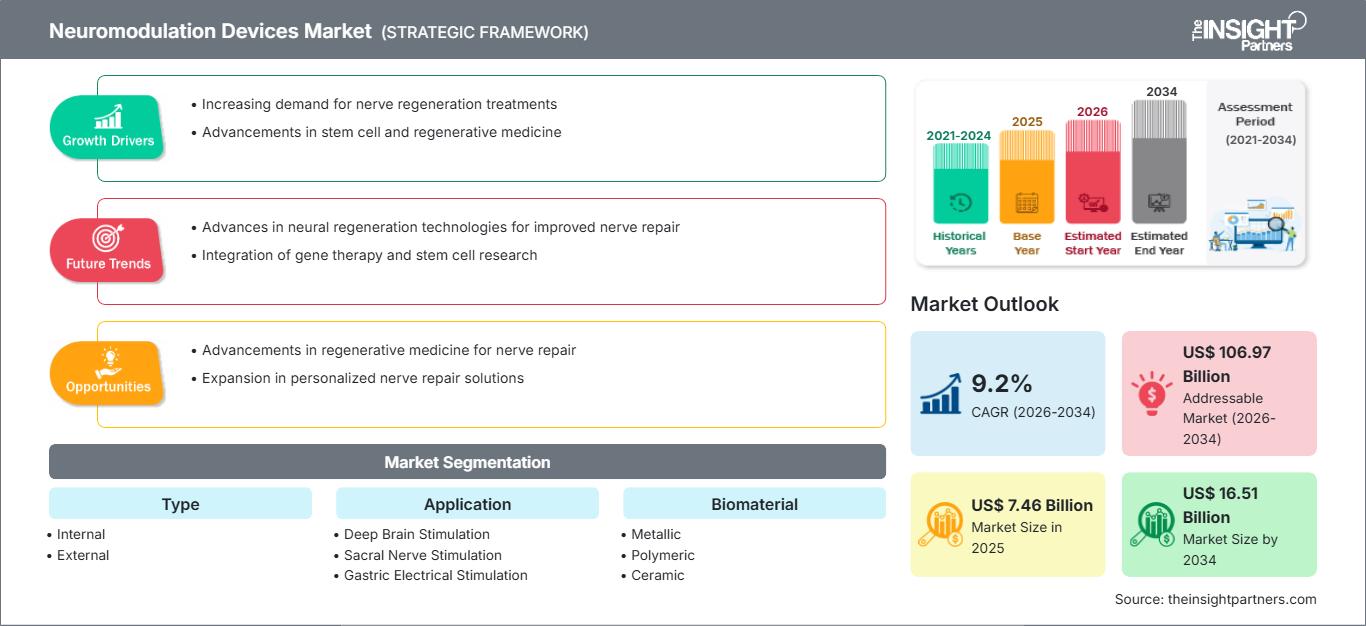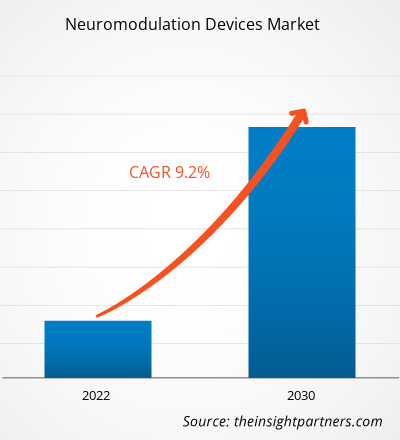2025年,神经调控设备市场规模为74.6亿美元,预计到2034年将达到165.1亿美元,2026年至2034年期间的复合年增长率(CAGR)为9.2%。市场环境持续变化,为利益相关者带来新的机遇。整体而言,市场呈现稳定发展态势,并具有长期增长潜力。
神经调控技术正迅速发展,其应用涵盖了多种植入式和非侵入式技术,用于治疗神经精神和神经系统疾病。颅内皮层刺激 (ICS)、经颅磁刺激 (TMS)、深部脑刺激 (DBS) 和经颅直流电刺激 (tDCS) 等疗法已在多种神经精神和神经系统疾病中展现出良好的疗效。神经调控设备是能够调节神经系统活动的先进医疗仪器。该技术可用于治疗运动障碍,例如肌张力障碍、帕金森病、震颤;耳鸣;强迫症;感觉障碍;癫痫;膀胱控制障碍;头痛;慢性疼痛;中风;微意识状态;痉挛;以及脊髓损伤。脊髓损伤病例的增加和神经系统疾病患病率的上升等因素,推动了神经调控设备市场规模的增长。
市场驱动因素:
老年人群易患神经系统疾病。常见的老年人神经系统疾病包括神经病变、帕金森病、阿尔茨海默病、肌张力障碍等。根据联合国经济和社会事务部的数据,2022年全球65岁及以上人口为7.71亿。预计到2034年,老年人口将达到9.94亿,到2050年将达到16亿。美国和加拿大等国家老年人口不断增长,导致运动障碍和精神疾病的患病率较高。帕金森基金会指出,帕金森病症状通常在60岁左右出现。
加拿大心理学会指出,强迫症(OCD)影响着加拿大约2%的人口。世界卫生组织(WHO)指出,癫痫是一种引起癫痫发作的神经系统疾病,影响着全球约5000万人。根据美国神经病学会的数据,中风是美国第三大死因,阿尔茨海默病位列第六。同一机构的统计数据显示,近100万美国人患有帕金森病,每年至少新增6万例病例。神经系统疾病的日益普遍,以及抑郁症和慢性疼痛等生活方式相关疾病的增加,促使人们对高科技产品的需求不断增长。
因此,老年人口不断增长,易患神经系统疾病,疾病患病率不断上升,以及人们对神经系统疾病带来的巨大负担的认识不断提高,推动了神经调节设备市场的增长。
神经科学专注于治疗中风、头痛、多发性硬化症和其他严重疾病。近年来,即使在发达国家,熟练的神经外科医生也相对短缺。在美国,有超过5700家医院,但这些医院的神经外科医生却不足3700人。造成神经外科医生短缺的一个重要原因是无法在合理的时间内培养出足够数量的合格神经外科医生。城市地区拥有配备先进技术的神经科医疗设施,但由于缺乏专业人员,农村地区能够获得的治疗有限。因此,熟练神经外科医生的短缺阻碍了神经调控设备市场的增长。
根据您的需求定制此报告
您可以免费获得任何报告的定制服务,包括本报告的部分内容、国家/地区层面的分析、Excel 数据包,以及面向初创企业和高校的优惠折扣。
神经调控设备市场:战略洞察

-
获取本报告的主要市场趋势。这份免费样品将包含数据分析,内容涵盖市场趋势、估算和预测等。
报告细分和范围:
“神经调节设备市场分析”是通过考虑类型、应用、生物材料和最终用户等细分市场进行的。
细分市场分析:
按类型划分,神经调控设备市场可分为体外和体内两大类。2022年,体内神经调控设备占据了更大的市场份额。然而,预计体外神经调控设备在2022年至2030年期间的复合年增长率(CAGR)将更高。“体内神经调控”是指利用医疗设备,通过电刺激、化学刺激或其他方式刺激特定的神经元靶点,从而调节或改变神经系统的活动。该技术用于治疗神经血管疾病、运动障碍、癫痫、慢性疼痛以及大小便失禁。
按最终用户划分,神经调控设备市场可分为医院、诊所和家庭医疗保健三大领域。2022年,医院领域占据了神经调控设备市场份额的主导地位。由于众多医院和诊所的扩张以及政府在医疗基础设施建设方面投入的增加,医院领域目前主导着市场。此外,人口老龄化预计将导致慢性疼痛患病率上升,从而推动医院对神经调控设备的需求。
区域分析:
神经调节设备市场报告的范围主要分为北美(美国、加拿大和墨西哥)、欧洲(西班牙、英国、德国、法国、意大利和欧洲其他地区)、亚太地区(韩国、中国、印度、日本、澳大利亚和亚太其他地区)、中东和非洲(南非、沙特阿拉伯、阿联酋和中东及非洲其他地区)以及南美和中美洲(巴西、阿根廷和南美及中美洲其他地区)。
就收入而言,北美在 2022 年占据了神经调节设备市场份额的主导地位。神经系统疾病的日益普遍、研发投入的增加、FDA 产品批准数量的增加以及技术的进步,都推动了该地区对神经调节设备的需求。
神经调控装置
神经调控设备市场区域洞察
The Insight Partners 的分析师对预测期内影响神经调控设备市场的区域趋势和因素进行了详尽的阐述。本节还探讨了北美、欧洲、亚太、中东和非洲以及南美和中美洲等地区的神经调控设备市场细分和地域分布。
神经调控设备市场报告范围
| 报告属性 | 细节 |
|---|---|
| 2025年市场规模 | 74.6亿美元 |
| 到2034年市场规模 | 165.1亿美元 |
| 全球复合年增长率(2026-2034 年) | 9.2% |
| 史料 | 2021-2024 |
| 预测期 | 2026-2034 |
| 涵盖部分 |
按类型
|
| 覆盖地区和国家 |
北美
|
| 市场领导者和主要公司简介 |
|
神经调控设备市场参与者密度:了解其对商业动态的影响
神经调控设备市场正快速增长,这主要得益于终端用户需求的不断增长,而终端用户需求的增长又源于消费者偏好的转变、技术的进步以及对产品益处的认知度提高等因素。随着需求的增长,企业不断拓展产品和服务,持续创新以满足消费者需求,并把握新兴趋势,这些都进一步推动了市场增长。

- 获取神经调控设备市场主要参与者概览
竞争格局及主要公司:
神经调控设备市场报告重点关注市场上的主要参与者,例如雅培(圣犹达医疗公司)、LivaNova PLC、波士顿科学公司、Aleva Neurotherapeutics SA、Bioventus、EnteroMedics Inc、Nevro Corporation、NeuroPace Inc、Synapse Biomedical Inc 和 Neurosigma Inc。该神经调控设备市场预测可以帮助利益相关者制定增长战略。这些公司致力于新技术研发、现有产品升级和市场扩张,以满足全球不断增长的消费者需求。根据公司新闻稿,以下是一些近期重要进展:
- 2023年8月,美敦力公司(Medtronic plc)的Inceptiv闭环可充电脊髓刺激器(SCS)获得CE认证。这是美敦力首款采用闭环功能的SCS设备,能够感知每个人的独特生物信号,并根据需要实时调整刺激强度,使治疗与日常生活活动保持协调一致。
- 2023年8月,雅培公司获得美国食品药品监督管理局(FDA)批准,推出采用FlexBurst360疗法的新型Proclaim Plus脊髓刺激(SCS)系统。作为雅培公司专有BurstDR刺激技术的下一代产品,FlexBurst360疗法可覆盖躯干和/或四肢的六个疼痛区域,并可根据患者的治疗需求进行个性化设置。
- 历史分析(2 年)、基准年、预测(7 年)及复合年增长率
- PEST和SWOT分析
- 市场规模、价值/数量 - 全球、区域、国家
- 行业和竞争格局
- Excel 数据集
近期报告
客户评价
购买理由
- 明智的决策
- 了解市场动态
- 竞争分析
- 客户洞察
- 市场预测
- 风险规避
- 战略规划
- 投资论证
- 识别新兴市场
- 优化营销策略
- 提升运营效率
- 顺应监管趋势






















 获取免费样品 - 神经调节设备市场
获取免费样品 - 神经调节设备市场